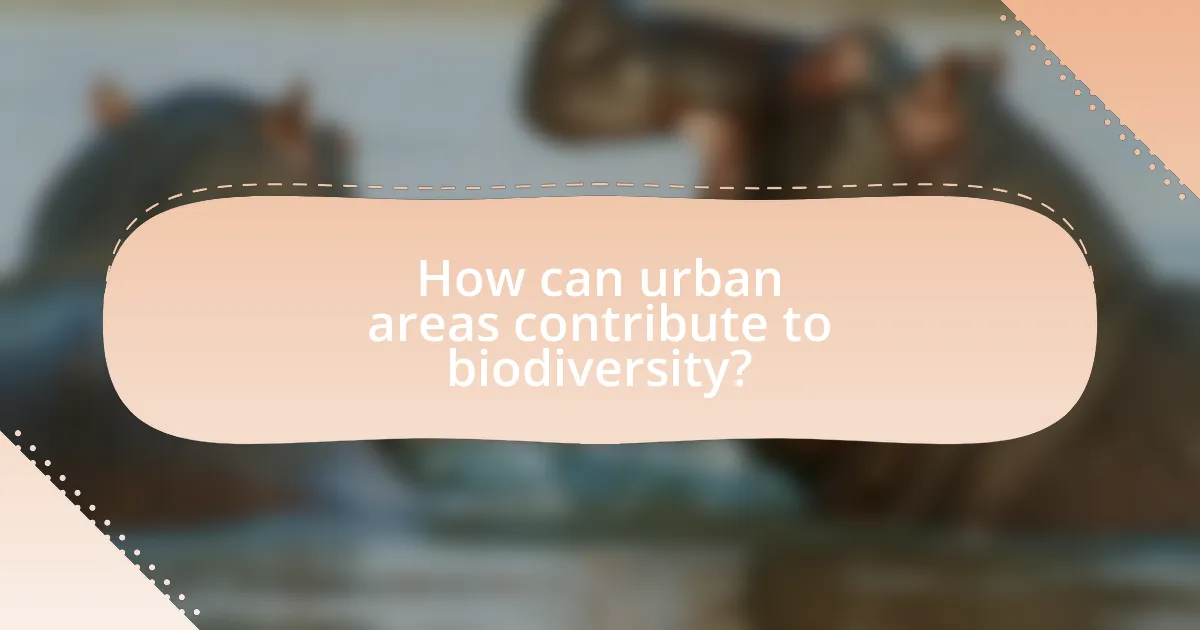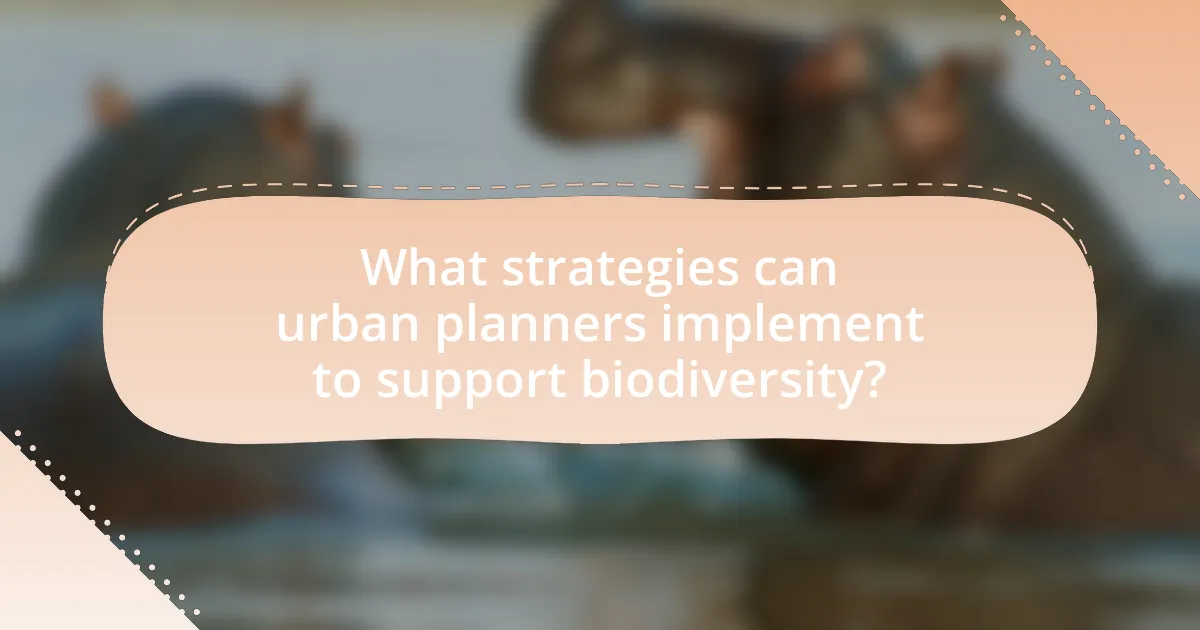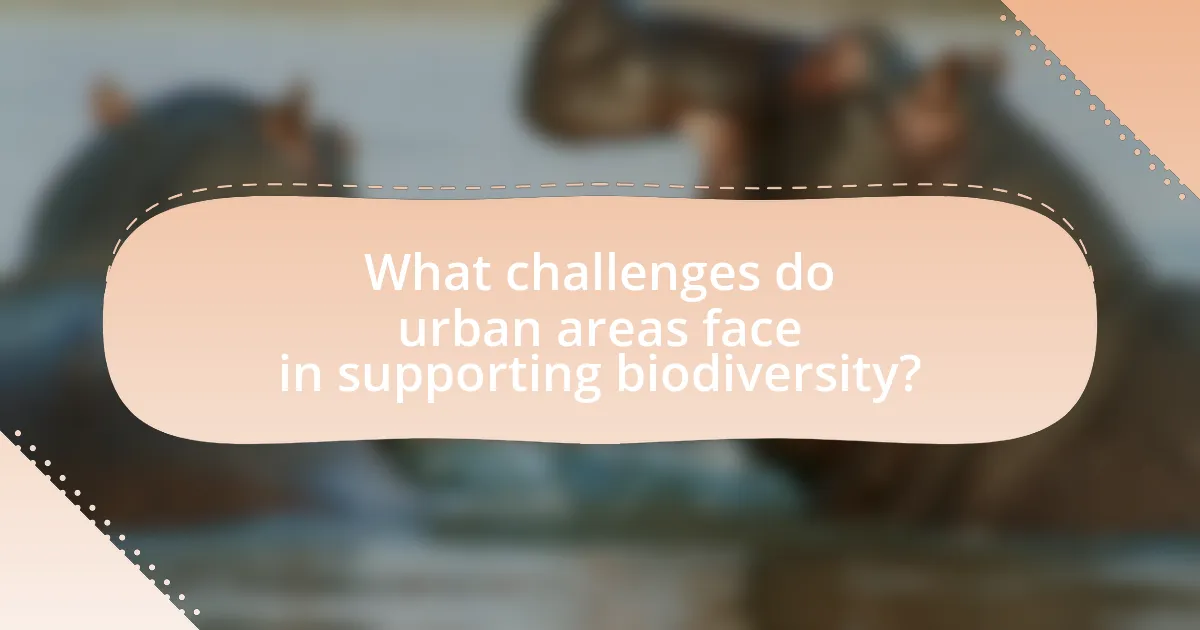Urban areas can play a significant role in supporting biodiversity through the incorporation of green spaces, such as parks, gardens, and green roofs, which provide essential habitats for various species. These green spaces enhance ecological connectivity, allowing wildlife to thrive despite urbanization. The article explores the importance of biodiversity in urban settings, highlighting its benefits for ecosystem services, public health, and resilience to environmental changes. It also discusses strategies for urban planners, the impact of community initiatives, and the challenges faced in maintaining biodiversity, while offering practical solutions for individuals to contribute to urban ecological health.

How can urban areas contribute to biodiversity?
Urban areas can contribute to biodiversity by incorporating green spaces, such as parks, gardens, and green roofs, which provide habitats for various species. These green spaces enhance ecological connectivity, allowing wildlife to thrive in urban settings. For instance, a study published in the journal “Urban Ecology” found that urban parks can support a diverse range of flora and fauna, including pollinators like bees and butterflies, which are crucial for ecosystem health. Additionally, urban areas can implement sustainable practices, such as rain gardens and native plant landscaping, which further promote biodiversity by creating environments that support local wildlife and reduce habitat fragmentation.
What are the key roles of urban areas in supporting biodiversity?
Urban areas play a crucial role in supporting biodiversity by providing habitats, facilitating species movement, and promoting ecological interactions. These areas can incorporate green spaces, such as parks and gardens, which serve as refuges for various species, including pollinators and birds. Research indicates that urban green spaces can enhance species richness; for example, a study published in “Urban Ecology” by McKinney (2002) found that cities can support a diverse range of flora and fauna despite their dense human populations. Additionally, urban areas can act as corridors that connect fragmented habitats, allowing for the movement of species and genetic exchange, which is essential for maintaining healthy populations. Furthermore, urban planning that prioritizes biodiversity can lead to sustainable ecosystems, as evidenced by initiatives in cities like Singapore, where integrated green infrastructure has significantly increased urban biodiversity.
How do urban green spaces enhance biodiversity?
Urban green spaces enhance biodiversity by providing habitats for various species, including plants, insects, birds, and mammals. These areas, such as parks, gardens, and green roofs, create ecological niches that support diverse life forms. Research indicates that urban green spaces can increase species richness; for example, a study published in the journal “Urban Ecology” found that urban parks can host up to 50% of the species found in nearby natural areas. Additionally, green spaces facilitate ecological connectivity, allowing species to move between fragmented habitats, which is crucial for maintaining genetic diversity and ecosystem resilience.
What impact do urban gardens have on local ecosystems?
Urban gardens significantly enhance local ecosystems by increasing biodiversity and providing habitats for various species. These gardens serve as green spaces that support pollinators, such as bees and butterflies, which are crucial for plant reproduction. Research indicates that urban gardens can host a variety of flora and fauna, contributing to the overall ecological health of urban areas. For instance, a study published in the journal “Urban Ecology” found that urban gardens can increase species richness by up to 30% compared to surrounding non-garden areas. This increase in biodiversity helps to stabilize ecosystems, improve air quality, and promote soil health, demonstrating the vital role urban gardens play in fostering ecological balance within cities.
Why is biodiversity important in urban settings?
Biodiversity is important in urban settings because it enhances ecosystem services, improves public health, and increases resilience to environmental changes. Urban biodiversity contributes to air and water purification, climate regulation, and pollination, which are essential for maintaining the quality of life in densely populated areas. Studies show that cities with higher biodiversity levels experience reduced urban heat effects and better stormwater management, leading to lower flooding risks. Additionally, diverse green spaces promote mental well-being and physical health among residents, as evidenced by research indicating that access to nature can reduce stress and improve overall health outcomes.
How does biodiversity improve urban resilience?
Biodiversity improves urban resilience by enhancing ecosystem services that mitigate environmental stressors. Diverse plant and animal species contribute to better air and water quality, reduce urban heat, and increase stormwater management capabilities. For instance, urban green spaces with varied vegetation can absorb rainwater, reducing flooding risks and improving water infiltration. Studies show that cities with higher biodiversity levels experience less severe impacts from climate change, such as heatwaves and flooding, due to the presence of natural buffers. This relationship underscores the importance of integrating biodiversity into urban planning to foster resilient urban environments.
What are the social benefits of urban biodiversity?
Urban biodiversity provides significant social benefits, including enhanced community well-being, improved mental health, and increased social cohesion. Access to diverse green spaces in urban areas has been shown to reduce stress and promote physical activity, contributing to better mental health outcomes. Studies indicate that neighborhoods with higher biodiversity often experience stronger community ties, as residents engage more with their environment and each other. Furthermore, urban biodiversity can foster educational opportunities, allowing communities to learn about ecosystems and sustainability, which can lead to increased environmental stewardship.

What strategies can urban planners implement to support biodiversity?
Urban planners can implement strategies such as creating green corridors, enhancing urban green spaces, and integrating native plant species to support biodiversity. Green corridors facilitate wildlife movement and connectivity between habitats, which is essential for species survival. Enhancing urban green spaces, such as parks and community gardens, increases habitat availability and promotes ecosystem services. Integrating native plant species into landscaping supports local wildlife, as these plants provide food and shelter for native fauna. Research indicates that urban areas with diverse green spaces can support higher levels of biodiversity, demonstrating the effectiveness of these strategies in fostering ecological resilience.
How can zoning laws promote biodiversity in cities?
Zoning laws can promote biodiversity in cities by designating specific areas for green spaces, wildlife habitats, and sustainable development. These regulations encourage the preservation of natural ecosystems and the integration of green infrastructure, such as parks and green roofs, which provide habitats for various species. For instance, cities that implement zoning laws to protect wetlands or forests can maintain critical habitats that support diverse flora and fauna. Additionally, zoning can facilitate the creation of wildlife corridors, allowing species to migrate and thrive within urban environments. Studies have shown that cities with effective zoning policies experience higher levels of biodiversity, as these laws help mitigate habitat loss and fragmentation.
What are the benefits of mixed-use developments for biodiversity?
Mixed-use developments benefit biodiversity by integrating residential, commercial, and recreational spaces, which promotes habitat diversity and connectivity. This integration allows for the creation of green spaces, such as parks and community gardens, that support various species and enhance ecosystem services. Research indicates that mixed-use areas can increase species richness by providing diverse habitats and reducing urban heat islands, which can be detrimental to local wildlife. Additionally, these developments often incorporate sustainable practices, such as rainwater harvesting and green roofs, which further contribute to biodiversity by improving water quality and providing additional habitats.
How can urban infrastructure be designed to support wildlife?
Urban infrastructure can be designed to support wildlife by incorporating green spaces, wildlife corridors, and sustainable building practices. Green spaces, such as parks and gardens, provide habitats and food sources for various species, while wildlife corridors facilitate safe movement between habitats, reducing roadkill and habitat fragmentation. Sustainable building practices, including green roofs and permeable surfaces, enhance biodiversity by creating microhabitats and improving water management. Research indicates that urban areas with integrated green infrastructure can increase species richness and abundance, demonstrating the effectiveness of these design strategies in promoting urban biodiversity.
What role do community initiatives play in enhancing urban biodiversity?
Community initiatives play a crucial role in enhancing urban biodiversity by fostering local engagement and promoting conservation practices. These initiatives often involve residents in activities such as planting native species, creating community gardens, and restoring natural habitats, which directly contribute to increased species diversity and ecosystem health. For instance, a study published in the journal “Biodiversity and Conservation” found that urban green spaces managed by community groups showed a 30% increase in native plant species compared to areas without such initiatives. This demonstrates that community-led efforts can effectively enhance urban biodiversity, making cities more resilient and ecologically diverse.
How can citizen science contribute to urban biodiversity efforts?
Citizen science can significantly contribute to urban biodiversity efforts by engaging the public in data collection and monitoring of local species and habitats. This involvement enhances the understanding of urban ecosystems, as citizens can report sightings of flora and fauna, which helps in mapping biodiversity hotspots and tracking changes over time. For instance, projects like the City Nature Challenge have demonstrated that citizen-collected data can lead to the discovery of previously unrecorded species in urban areas, thereby informing conservation strategies. Furthermore, studies indicate that citizen science initiatives can increase public awareness and appreciation of biodiversity, fostering community stewardship and support for urban conservation efforts.
What are successful examples of community-led biodiversity projects?
Successful examples of community-led biodiversity projects include the Urban Wildlife Project in San Francisco, which engages local residents in habitat restoration and species monitoring, leading to increased biodiversity in urban green spaces. Another example is the Green Streets initiative in Portland, where community members participate in creating green infrastructure, such as rain gardens, which enhance urban ecosystems and improve water quality. These projects demonstrate the effectiveness of community involvement in fostering biodiversity, as evidenced by the documented increase in native species and improved ecological health in these urban areas.

What challenges do urban areas face in supporting biodiversity?
Urban areas face significant challenges in supporting biodiversity, primarily due to habitat loss, pollution, and climate change. Habitat loss occurs as urban development replaces natural landscapes with buildings and infrastructure, reducing the space available for various species. Pollution from vehicles, industrial activities, and waste contributes to the degradation of air and water quality, adversely affecting both flora and fauna. Additionally, climate change exacerbates these issues by altering habitats and species distributions, making it difficult for many organisms to adapt or survive in urban environments. These factors collectively hinder the ability of urban areas to maintain and promote biodiversity effectively.
How does urbanization negatively impact local wildlife?
Urbanization negatively impacts local wildlife by destroying habitats, leading to population declines and species extinctions. As cities expand, natural landscapes are replaced with buildings and infrastructure, which reduces the available space for wildlife to thrive. For instance, a study published in the journal “Biological Conservation” found that urban development can lead to a 75% reduction in local biodiversity due to habitat fragmentation and loss. Additionally, urban areas often introduce pollution and invasive species, further threatening native wildlife.
What are the effects of pollution on urban biodiversity?
Pollution negatively impacts urban biodiversity by reducing species richness and altering ecosystem functions. Air, water, and soil pollutants can lead to habitat degradation, which diminishes the availability of resources for various species. For instance, studies have shown that heavy metals and chemicals in urban runoff can harm aquatic life, leading to decreased populations of sensitive species. Additionally, air pollution can affect plant health, reducing the availability of food and habitat for herbivores and, consequently, their predators. Research indicates that urban areas with high pollution levels often exhibit lower biodiversity indices compared to cleaner environments, highlighting the detrimental effects of pollution on urban ecosystems.
How does habitat fragmentation affect species diversity in cities?
Habitat fragmentation negatively impacts species diversity in cities by isolating populations and reducing habitat availability. This isolation limits gene flow between populations, leading to inbreeding and decreased genetic diversity, which can make species more vulnerable to diseases and environmental changes. Studies have shown that fragmented habitats often support fewer species compared to continuous habitats; for instance, a study published in the journal “Ecological Applications” found that urban areas with fragmented green spaces had significantly lower bird diversity than those with larger, connected habitats. Additionally, habitat fragmentation can create edge effects, which alter microclimates and increase competition from invasive species, further diminishing native biodiversity.
What solutions exist to overcome these challenges?
Solutions to overcome challenges in supporting biodiversity in urban areas include implementing green infrastructure, creating wildlife corridors, and promoting community engagement in conservation efforts. Green infrastructure, such as green roofs and urban parks, enhances habitat availability and improves ecosystem services. Wildlife corridors facilitate species movement and genetic exchange, which is crucial for maintaining biodiversity. Community engagement initiatives, such as citizen science projects and educational programs, foster awareness and active participation in local conservation efforts, leading to more sustainable urban environments. These strategies have been shown to effectively mitigate the negative impacts of urbanization on biodiversity.
How can green infrastructure mitigate biodiversity loss in urban areas?
Green infrastructure can mitigate biodiversity loss in urban areas by creating habitats that support diverse species and enhancing ecological connectivity. For instance, green roofs, urban parks, and tree canopies provide essential resources such as food and shelter for various organisms, thereby promoting species diversity. Research indicates that urban green spaces can increase local biodiversity by up to 30%, as they serve as refuges for native species and facilitate movement between fragmented habitats. Additionally, green infrastructure helps to manage stormwater, reduce urban heat, and improve air quality, which further supports the health of ecosystems and the species that inhabit them.
What policies can support biodiversity conservation in cities?
Policies that can support biodiversity conservation in cities include the establishment of green infrastructure, habitat protection regulations, and urban planning that prioritizes ecological sustainability. Green infrastructure, such as parks, green roofs, and urban forests, enhances habitat connectivity and provides essential ecosystem services. For instance, cities like Singapore have implemented extensive green roofs and vertical gardens, which contribute to biodiversity by providing habitats for various species. Habitat protection regulations, such as zoning laws that restrict development in ecologically sensitive areas, help preserve critical habitats. Additionally, urban planning that incorporates biodiversity goals into land-use policies can lead to more sustainable urban environments. Research indicates that cities that integrate biodiversity considerations into their planning processes can significantly enhance urban ecosystems and improve overall environmental health.
What practical steps can individuals take to support biodiversity in urban areas?
Individuals can support biodiversity in urban areas by creating and maintaining native plant gardens. Native plants provide essential habitats and food sources for local wildlife, including pollinators like bees and butterflies. Research indicates that urban gardens with native flora can increase local species richness by up to 50%. Additionally, individuals can participate in community clean-up efforts to reduce pollution and litter, which negatively impacts urban ecosystems. Engaging in citizen science projects, such as bird counts or plant surveys, helps monitor local biodiversity and contributes valuable data to conservation efforts. Lastly, advocating for green spaces and sustainable urban planning can lead to the preservation and enhancement of habitats within cities.